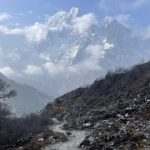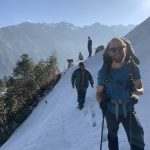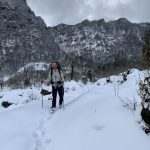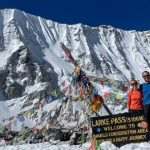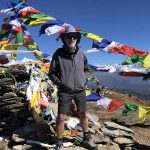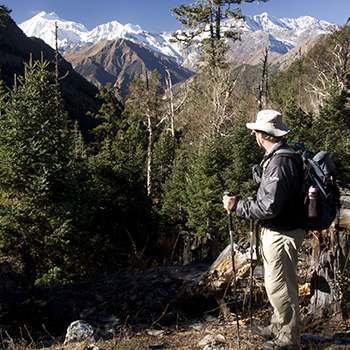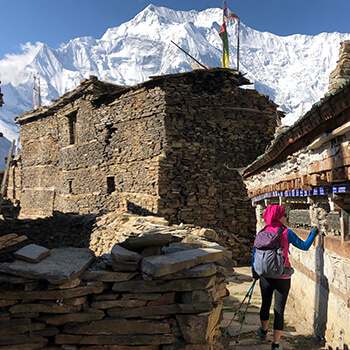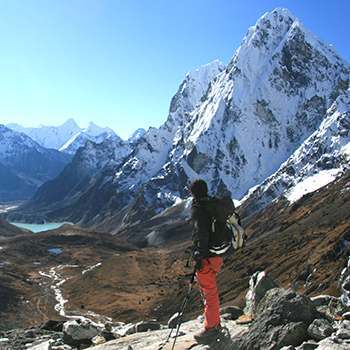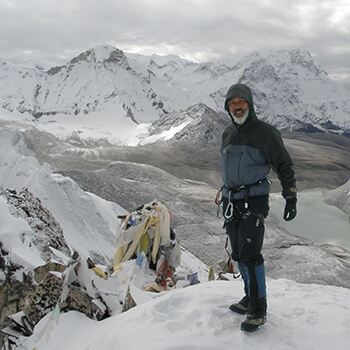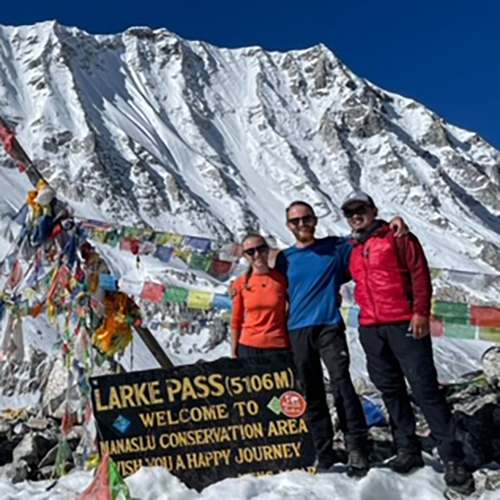
When Jacinda closes a door, a window opens to Nepal!
The lows and highs of the GHT by Graham and Anna
My partner and I had been wanting a big adventure for quite a while and we had planned to walk at least the southern part of the Te Arora in New Zealand. We were fortunate that an opportunity to take 6 months off work (Oct-April) arose, COVID was starting to recede and so we took our chances. We headed to Australia and waited hopefully for the travel corridor to open with NZ. Unfortunately, the day after we landed in Australia the iron curtain was brought down and New Zealand was closed off to non-residents until at least April 2022. F***. A frantic few days researching for another thru-hike we could do/plan from a hostel in Coogee. PCT and the Appalachian trail were off the cards, given the time of year, and since we didn’t speak Spanish we thought the Patagonia trail was also not ideal. We then stumbled across the GHT website and bought the book. Robin swiftly e-mailed us and the planning started from there!
We were a little too early in the season for a big thru-hike along the GHT, and so decided to fill the first few months in Australia visiting friends, family and a few shorter multi-day hikes to work on our fitness (would highly recommend the Port-Davey and South Coast track in Tasmania for 9-11 days of being totally self reliant and out in the wilderness).
Our GHT Planning Gets Going
We were keen to try and combine a variety of experiences into our hike- some solo walking, some guided sections to get into areas requiring permits, and also we wanted to try and push ourselves to try some more technical sections with support (as we had little mountaineering/alpine experience between us). There are so many different options and ways to do the GHT that we would really recommend talking through your plans with someone who’s done it before- we would have been clueless without the help we got. Other things to factor in are the time of year and the feasibility of different passes in different seasons. Unfortunately, some things just can’t be predicted though- more on that later!
So after careful consideration and help from Robin we settled on our version of the GHT. We were also incredibly fortunate to be introduced to Pema Sherpa (Pema Treks & Expeditions), who was with Robin for a lot of his first GHT and was amazing in sorting out lots of our logistics from Kathmandu, permits, flights, other transport and just generally wonderful supportive messages along the way!
We would do the first 30 days walking on our own and on the ‘low route’ before joining up to the high route for the next 30 days with a mix of assistance along this section. We had a pretty tight itinerary getting to the end of our route at Jomsom, with just one day before flying home (hindsight – would not recommend this!). We also had a Garmin In-reach which we used for our friends and families to track our adventure as well as being able to send satellite messages if needed/SOS function.
The Adventure Begins!
We started in the far east near the Indian border in a town called Taplejung (short flight and a long Jeep from Kathmandu) on 10th Feb and due to the heaviest snowfall in 35 years (according to the locals) the start of our journey to the Indian border and back wasn’t possible, so we immediately gained an extra 5 days on our itinerary! We changed our itinerary regularly on the move and I’d say flexibility is one of the most important things to have whilst embarking on the GHT, be ready to change plans for weather, landslides, goats or any eventuality at any time and be ready to sometimes ‘let it be’.
Our low route took us from Taplejung to The Last Resort via Tumlingtar, the Arun-Solu trek, quick up and down the Khumbu to Namche, Jiri, Bigu Gompa and then onto the Last Resort. These 30 days were without a guide and probably the toughest half despite not being particularly technical. The highest point on this half was only 3500m but heavy snowfall, non-commercial routes and few (none before the Khumbu) tourists made some of the navigation difficult. It was this section that really made us wish we’d learnt a bit more Nepali! It’s very different to the later, more tourist filled regions in Nepal. We were much more reliant on asking around in local villages for the places to eat and sleep rather than relying on big signs in English. On reflection I think we carried too much for these 30 days but when we’ve spoke about it after we’d really struggle to leave any of it behind. We camped for 7 of these days and had to cook our own food for these days as well; Australia has excellent ranges of camping meals…and for cooking we used a Trangia with some surgical spirits we picked up from the health post in Taplejung. *Note- you can’t fly with gas canisters for any stoves… and you can’t buy them outside of the big tourist hot spots either!
Himalaya Weather isn’t Predictable
From the Last Resort we’d planned to join the high route, head into Langtang via Tilman’s pass, onto Ruby Valley before Manaslu and finishing with the Annapurna circuit as far as Jomsom. We’d also used an extra day we gained to relax, wash some clothes and try to wash the dust off our face (Nepali roads are the dustiest things in the world – Nepali powder).
Given our limited mountaineering experience we hired a guide to meet us with a camping team for going over the slightly technical, glaciated Tilman’s pass. This also allowed us to send some of our gear back to Kathmandu, tent, trangia etc, significantly lightening the load. It was an absolute fantastic experience walking with the guide and the camping team, it allowed us to get to know people a bit more than we had been in the last month, gave us opportunity to explore their culture and hear their stories as well as have exceptional food magically made on the kerosene burner. It was early to mid March by this point and the aforementioned snow was causing us significant issues 5 days into this section. We unfortunately had to turn around when it became evident that we couldn’t even get to Panch Pokhari because of near chest deep snow – another time to just let it be. Not deterred too much, we got transport round to Syabru Besi and walked into the Langtang Valley from here, leaving the camping team in Kathmandu.
From this point onwards we were in relative luxury, great tea houses with full food menus and plenty of chocolate! Sunrise at Kyanjin Ri was a particular highlight as well as having great weather over both Larke La and Thorong La passes. We found Ruby Valley slightly challenging with long days and few places to stay since we didn’t have a tent any more, but that was only a few days between Langtang valley and Manaslu.
Our trekking through Manaslu and Annapurna were vastly different to that in the East; we were lucky to be able to ascend a bit quicker than other tourists given how long we’d been walking for and made up a bit of time so managed a short side trip to Tilicho Lake from Manang. We’d both highly recommend it, incredible views of the highest lake in Nepal, just be cautious on the landslide heading up to it! After 59 days of hiking we made it to Jomsom (in what appeared to be the windiest valley in Nepal), and eventually called it a day at Marpha on the way to Pokhara for some apple brandy to celebrate our GHT! What an inspiring and life-changing experience… And one that is so difficult to fully write about – we’ve attached a link to a video we made which hopefully helps to give some more insight into our trip. Hopefully we’ll be back soon to continue our journey into the west…
GHT Top Tips:
- Solar Power! We used a solar panel for the majority of our trip, particularly in the much less travelled east side. It was incredibly useful, especially in the non-infrequent power outages. Ours was a ‘sunjack 25W solar charger’ with 2 battery packs – frequently deployed on my bag like a tortoise shell!
- Learn basic Nepali – just simple phrases, asking for food, shelter, water are extremely useful and also very appreciated
- Flexibility – of both the mind and body 😉 yoga can be very useful when your back/legs are sore and screaming. Also flexibility to change plans at an instant is very important, it doesn’t always go the way you plan and you need to be adaptable and accepting of the change. Wise words from Anna’s 5 year old cousin ‘You get what you get, and you don’t get upset’
- Take a pack of cards – card games are international and can be a great way to make friends or lose money/sweets (try and play a game of flash/brag with a Nepali camping team!). Other games are encouraged- we think we hold a record for the highest ever game of Boggle at just over 5000m.
- Footcare – a pumice stone and Injiji liner socks saved our feet and subsequently gave us eternal happiness.
- Indulge in local delicacies – you’ll get daal bhat everywhere you go but also make sure you try some Raksi (local fire spirit), Chang (local beer either made with millet or rice) and Thongba (fermented millet, which you top up with hot water – delicious and hydrating all in one!)
- Embrace everything and have an incredible time!










